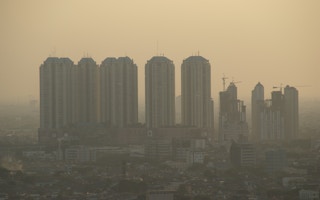Visitors to Southeast Asia may be surprised at the poor air quality recently. The region has enjoyed relatively good air quality for the last few years due to the slowdown of land-use change during Covid-19, and the wetter conditions during the La Nina years. However, many will also remember that the region has been beset with a recurring transboundary air pollution problem for decades. The most critical episodes occurred at various times: 1997-1998, 2002, 2004, 2006, 2010, 2013 and 2015.
In southern Southeast Asia, smoke haze is emitted from massive peatland fires in Sumatra and Borneo, where drainage and land clearance for agricultural plantations have dried out landscapes, making them extremely fire-prone. The problem of transboundary haze pollution is exacerbated during extreme drought periods such as the 1997-1998 and 2013-2015 El Nino years. The dry weather combined with strong winds carried the haze across the region. Meteorologists are reporting developing El Nino conditions this year. The drier conditions may signal a prolonged haze season ahead.
In the past week, Indonesian authorities ordered remote learning for schools in Palembang and Jambi cities due to the haze pollution. Last Friday, Malaysia issued pollution warnings in the western part of Peninsula Malaysia and Sarawak, blaming transboundary haze from Indonesia (which has been denied by the Indonesian authorities). Earlier in March this year, parts of Thailand, Laos and Myanmar were shrouded in haze. Thailand suffered its worst transboundary haze pollution with hazardous air quality levels exceeding World Health Organization limits for more than two weeks.
Climate change compounds the haze pollution problem. By now an oft-cited reason for environmental disasters, climate change acts as an amplifier of bad weather phenomenon — what is bad becomes worse. However, what most do not know is that climate change not only makes the haze worse; the haze itself is a serious driver of climate change.
Researchers are expecting more intense and frequent El Nino events with increased climate change. There is a dynamic and vicious cycle of haze and climate change in the region: balmy conditions further heighten the risk of fire in degraded peatlands, and drier weather means that putting out the fires, either through human intervention or rain, becomes more challenging. This only exacerbates the haze pollution problem.
“
It is now time to go beyond the diplomatic and academic space and get on the ground to persuade communities, corporations, and governments that it is in their best interests to conserve peatlands.
Sharon Seah, ISEAS – Yusof Ishak Institute and Helena Varkkey, Universiti Malaya
Southeast Asia is home to approximately 24 million hectares of peatlands, or 40 per cent of the world’s total. According to the UNEP, peatlands cover only three per cent of the world’s surface but hold almost 550 billion tonnes of carbon. The waterlogged conditions of the peatlands keep the organic material from decomposing, making it a powerful carbon sink. When drained in preparation for planting or other development activities, the organic material is exposed to the air, kick starting decomposition and the release of greenhouse gasses. When burnt, this process is accelerated, further speeding up global warming.
According to a February 2016 World Bank report, anthropogenic fires burned 2.6 million hectares of Indonesian land — the size of four and half times of Bali island — between June and October 2015. The economic cost to Indonesia in that year alone was estimated to be US$16.1 billion, equivalent to 1.9 per cent of the country’s GDP. According to the World Resources Institute, Indonesia emitted 1.62 billion metric tonnes of carbon dioxide in 2015, surpassing Russia to become the world’s fourth largest emitter. There are also other externalities: school closures, deaths, respiratory and other health costs as well as aviation, economic and tourism disruptions. There are also massive biodiversity losses, not only in Indonesia but in countries suffering alongside with it. For instance, WWF-Malaysia has highlighted the effects of prolonged haze causing the decline of bee colonies which would have a trickling down effect on trees and fruit pollination.
Transboundary haze pollution in Southeast Asia is acknowledged as a multi-faceted problem that requires inter-governmental cooperation and multi-stakeholder engagement with the local communities, provincial governments, corporations and civil society. ASEAN-level engagement over haze has been ongoing since the 1990s, and the Singapore Government enacted a transboundary haze pollution law in 2015. Analysis of the root causes, factors, impacts and implications of the haze have been well examined by scholars for years. Yet, the problem recurs year after year.
It is now time to go beyond the diplomatic and academic space and get on the ground to persuade communities, corporations, and governments that it is in their best interests to conserve peatlands. Put simply, every effort at keeping our store of carbon sequestered in our peatlands will help in our climate and haze mitigation. In this regard, the present momentum in the region in using carbon pricing instruments and the establishment of voluntary carbon emission trading markets (as Indonesia has recently done) could be a window of opportunity to incentivise stakeholders to scale-up their conservation efforts and generate quality carbon credits that can be monetised.
The United Kingdom, for example, has pioneered an innovative natural capital financing mechanism called the Peatland Code using a voluntary standard to provide independent validation and verification for peatland restoration projects. Through this, the UK has been registering some 200 peatland projects in its national registry and tracking the total peatland area restored and total amount of emission reductions using blended public and private financing. The Code assures investors of good practice and replaces the need for individual project audits.
Progress towards such opportunities in Southeast Asia’s peatlands must be inclusive. The results should be measurable, reportable, and verifiable according to global standards. While this may be challenging in the current governance landscape, the benefits are well worth it. For peatland communities, this could contribute to improved livelihoods. For corporations, the same could feed into their sustainability transitions. For governments, they can bolster national carbon inventory accounting. For the region, it could finally mean the achievement of the vision for a “Haze-Free ASEAN”.
This commentary was developed under the Asia-Pacific Network for Global Change Research Project on “Policy and governance approaches to cooperative mitigation of peatland carbon emissions and transboundary haze in Southeast Asia”, Reference Number CRRP2022-03MY-Muhamad Varkkey.
Sharon Seah is Senior Fellow and concurrent Coordinator at the ASEAN Studies Centre and Climate Change in Southeast Asia Programme, ISEAS – Yusof Ishak Institute. She is also editor of Building a New Legal Order for the Oceans.
Helena Varkkey is an Associate Professor of Environmental Politics and Governance at the Department of International and Strategic Studies, Universiti Malaya.
This article was first published in Fulcrum, ISEAS – Yusof Ishak Institute’s blogsite.










